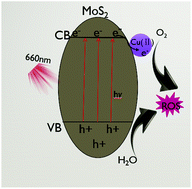The rapid photoresponsive bacteria-killing of Cu-doped MoS2†
Abstract
Bacterial infection is a serious public health issue because this may cause bacterial pneumonia and bacteria-infected sepsis. The conventional antibiotic therapy can cause bacterial resistance and other adverse effects. Herein, we designed a novel photoresponsive hybrid, in which MoS2 nanosheets were doped with copper ions (MoS2@Cu2+). This system can effectively kill bacteria under 660 nm visible light irradiation due to enhanced photocatalytic and photothermal performances. The underlying mechanism is that when doping copper ions in MoS2, the photogenerated electrons can be rapidly transferred from the conduction band of MoS2 to copper ions, consequently reducing the electron–hole recombination, thereby enhancing the yield of radical oxygen species (ROS). Besides the intrinsic photothermal performance of MoS2, the Cu2+ ion can absorb photons and transfer the photoenergy into heat due to the d–d transition of electrons, resulting in enhanced photothermal properties of MoS2@Cu2+ compared with pristine MoS2. Therefore, owing to the synergistic action of hyperthermia, ROS and released Cu2+, this system exhibited highly effective antibacterial efficacy when exposed to 660 nm light for 20 min, i.e., 99.64% against Staphylococcus aureus. The cytotoxicity test showed that the synthesized MoS2@Cu2+ had good biocompatibility. This system will be a potential platform for environmental disinfection, healing of bacteria-infected wounds and other rapid bacteria-killing fields.

- This article is part of the themed collections: Antibacterial Biomaterials and Biomaterials Science Most Popular 2020


 Please wait while we load your content...
Please wait while we load your content...